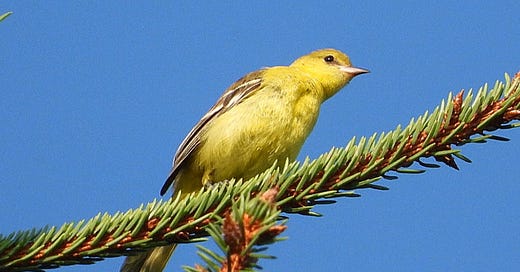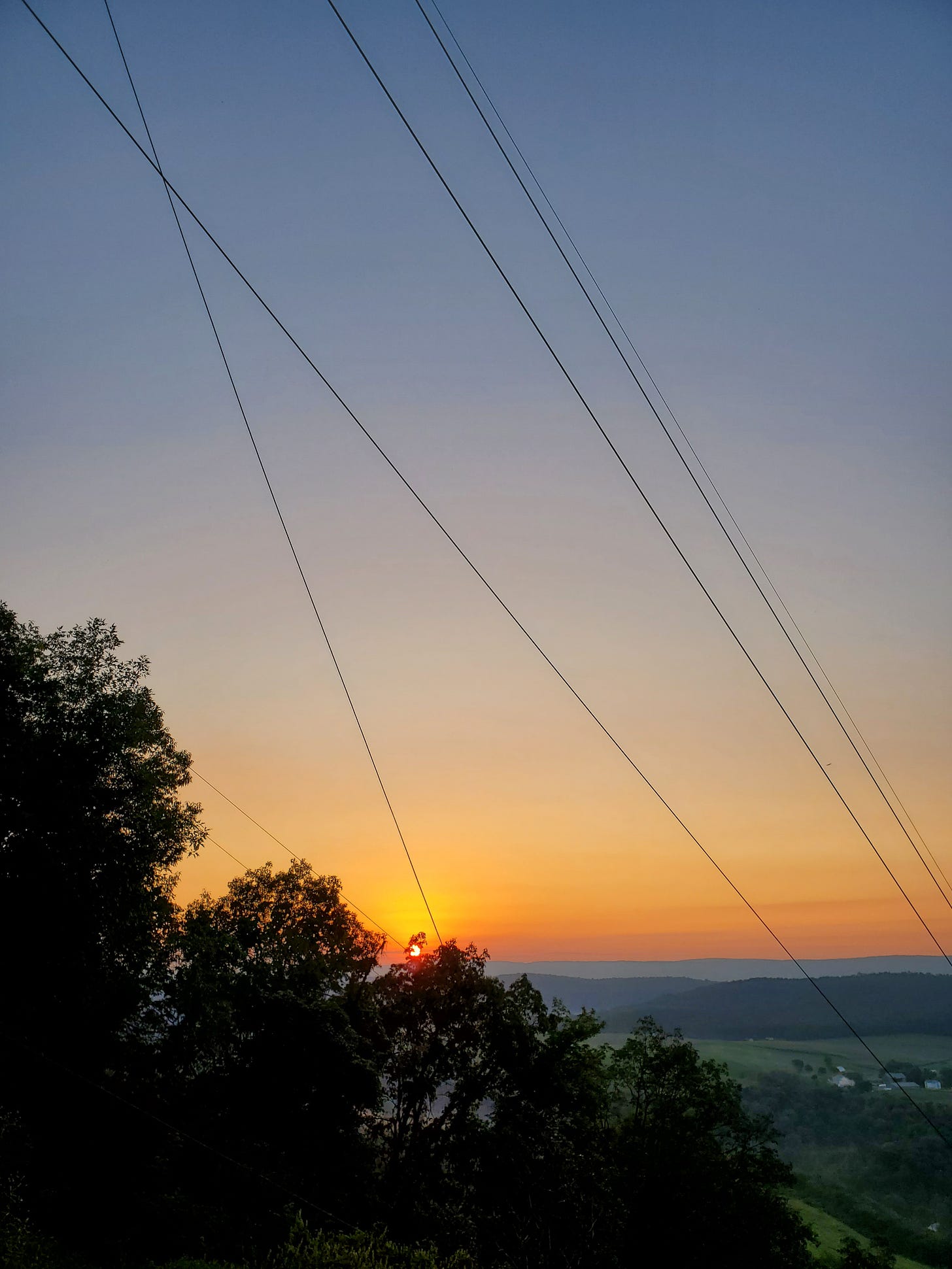Later, I’ll for-sure get another glimpse behind the katydid curtain, but for now, it’s time to hustle up to First Field to catch the end of it. Down in town, it’s a foggy, clammy 48, but on top it’s clear.
At 5:38 AM, I hear the improbable hoots of a Great Horned Owl from over on Laurel Ridge, not more than a quarter mile away. Seconds later, another responds from farther down the ridge. I wonder: could it be? Birds of the World later confirms that “male advertisement hooting” can begin as early as September in Pennsylvania. As the back and forth goes on and on for over half an hour, I have to think that the unseasonable cold has triggered this very-beginning-of-breeding-season behavior.
In the brilliant waning gibbous moonlight, Wood Thrushes are already up and clucking by 5:50, and then a Barred Owl, perhaps inspired by its larger cousin, calls once. Whip-poor-wills start up a bit later than usual, but make up for it in numbers, with at least three calling from different directions.
I got smart today and moved my sit spot to where I intercepted yesterday’s warbler cloud. After the owls and a few Veery NFCs, I hear two different terrestrial Swainson’s Thrushes close by, as if they’re in the goldenrod, which they might well be. A more familiar wichity gives away the hiding place of a Common Yellowthroat.
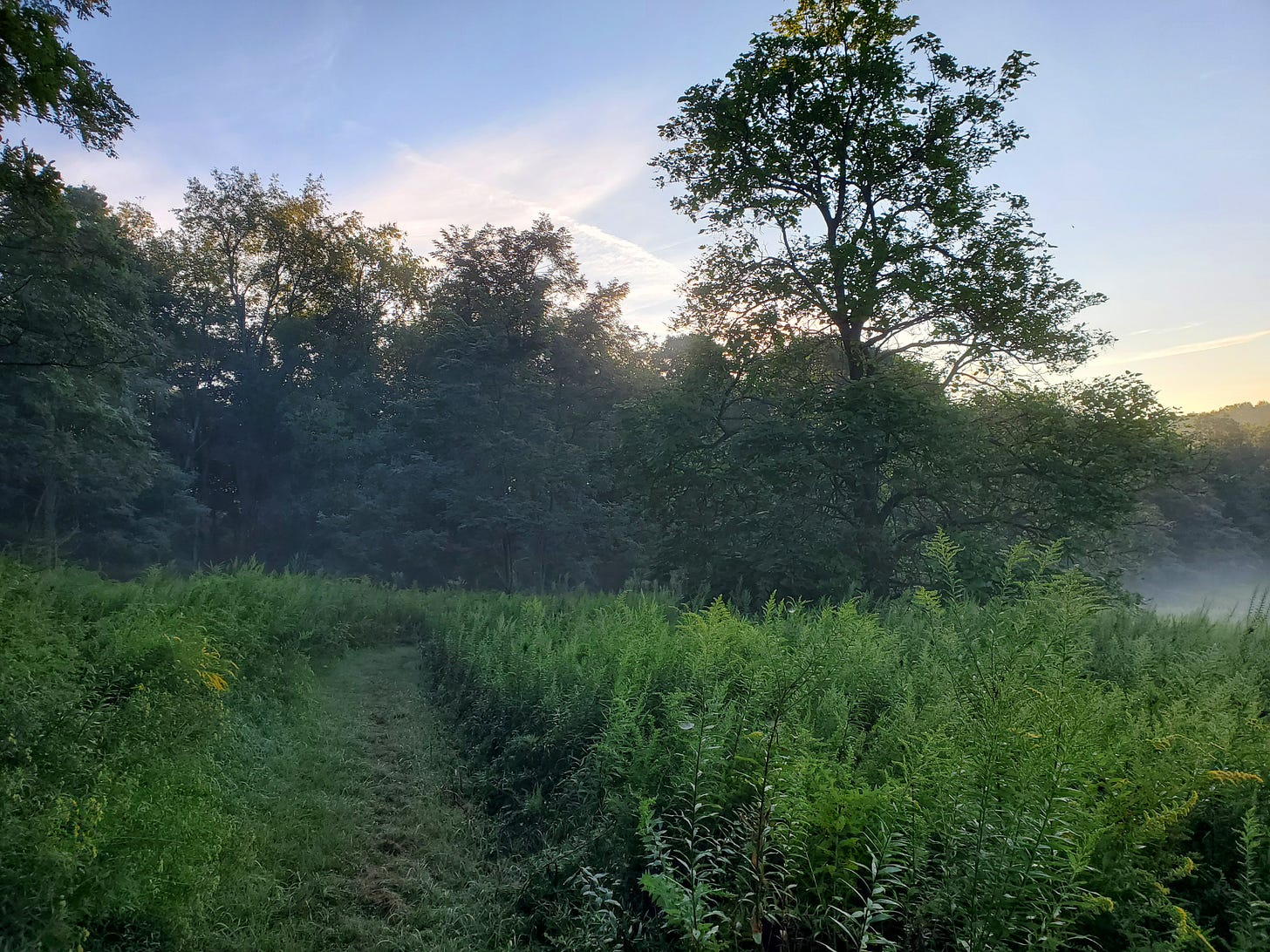
Today, there’s no lull. Warblers are everywhere up in the trees, as larger birds wake up all around me. Around 6:25 AM, I hear a weird, laughing complaint, which Merlin either doesn’t detect or could care less about. In my notes, I write “hahahahaha but cynical.” It occurs to me later that it might have been a squirrel.
Following Murphy’s Law, the warblers aren’t down in the goldenrod today, except an extremely loud Black-and-white Warbler that sings for several minutes. Over by the powerline on Laurel Ridge, a Broad-winged Hawk screeches.
The sun hits me at 6:54, and the first Red-eyed Vireo sings as if in response, second to last of the morning chorus. The very last, I’ve noticed, is the Yellow-throated Vireo, which sometimes doesn’t start singing until eight. Today, it begins not longer after the REVI, and is later joined by both a Blue-headed and a Warbling vireo.


At three until seven, the one I’ve been waiting for, an Eastern Screech-Owl, trills softly a few times from up on Sapsucker Ridge. I don’t think I would have ever predicted I could hear all three common owls on an early September dawn.
You’re Scaring the Towhees!
As I imagine all Hollow folk do, I talk to the deer. Sometimes, I admonish them. Today, as I’m packing my gear to hike, one snorts so loudly behind me that I scream in surprise. Apparently, I was in its way. Tell that to the towhees, which have flushed in various directions.
Despite—or perhaps because of—the gorgeous weather, the warblers are staying well up in the trees. As a consolation prize, I spot a rare flyby. An unmistakable Red-headed Woodpecker flies over the trees along Sapsucker Ridge, only the second record of the year.
At the Far Field, a male Black-throated Blue Warbler is the stand-out in a respectable mixed flock. Unbidden, it even sings its wheezy song several times.
On the way back, the Laurel Ridge woods are dead silent after 9 AM. Only the most insistent vocalizers, White-breasted Nuthatches and Red-bellied Woodpeckers, make a peep. At the powerline, Gray Catbirds and towhees refuse to be Yellow-breasted Chats, while at one of the oak deadenings farther on, an Olive-sided Flycatcher resolves itself into yet another Eastern Wood-Pewee.
Due Diligence
At 5 AM on Sunday, I groggily vow to sacrifice a dawn in the field to get a head start on two days of editing and writing. At 5:15 AM, after the caffeine kicks in, I think “What are you DOING?” and go for my gear. At the peak of migration, every dawn is precious, but I do have to be mindful that almost 365 days ago, a balcony dawn yielded a fly-by Red Crossbill. Nevertheless, neither a chat nor an Olive-sided are gonna get gotten by sitting in Tyrone.
This morning, the cold is gone and the katydids and mosquitoes are back. Indeed, we are in for a heatwave. At 5:40 AM, I’m sitting in an old favorite spot, the powerline cut overlooking Sinking Valley. If a chat is anywhere to be found and opts to vocalize, this would be it.
Up here, I manage to hear a couple Wood Thrushes, and once again, three different Whip-poor-wills, which triggers an eBird high-count alert. Roosters do not; it’s nice to hear them going off, though, along with the cows and, a bit later, Wild Turkeys, a species I haven’t detected in months. No Great Horned Owls, though. I would guess it’s too warm.
At 6:17 AM, the nearest House Wren finds me, and scolds Merlin into thinking it’s a Carolina Wren, or a Gray Catbird, both of which are also nearby. Later, the “Jenny wren” practices its repertoire and sounds quite a bit off, so I think it might be a juvenile.
The dawn chorus over here on Laurel Ridge is pretty weak, even for fall. As usual, the loudest things about are the American Crows, agitated by something, as always. One wonders if crows ever wake up and just lounge around, not getting excited. Impossible, I guess.
Some excitement at 6:48 in the stiff breeze (one of the things I love about the Laurel Ridge powerline cut). An American Kestrel hurdles across from the west and dives toward Sinking Valley, passing at a right angle through the morning European Starling commuter flock. Of the hundreds of starlings, one or two take an interest, but the falcon keeps going. Then, a would-be nemesis appears, chasing it relentlessly, diving in for the attack, harrying the kestrel as both disappear across the valley. A Ruby-throated Hummingbird, hopped up on chemicals and rage.
The other bit of drama, at least for me, is a silent mixed flock of Chimney Swifts and swallows rising up the side of the ridge, just after seven. I ID two Barn Swallows before they’re gone. This is the first-ever record of Barn Swallow for the hotspot after August. I’ve been trying for the last several years, but they seem to disappear magically in the last week of August, and the only one of its family I have gotten in the fall is a Tree Swallow.
No chat here, that’s for sure. Next, I walk a bit of Sapsucker Ridge Trail northward to visit some of the oak deadenings, but once again, no Olive-sided Flycatcher. At this point, I can say I’ve done my due diligence with these two species. In all fairness, we’ve detected the latter less than five times in 50 years, and never in the fall; the chat used to breed here, and we have detected it in the fall, but not for a long time. I just didn’t want to get to 199 and be left thinking that either of these would have put us over the top.
The Oriole-Thrush
As usual, Laurel Ridge is nearly silent, even as early as eight. Down by the lush deer exclosure forest, a quite odd mimic is going on and on, too faint for Merlin to hear. For once, I wish I carried a high-quality antenna. At first, it seems like a vireo, then like a mockingbird, but it’s neither of those, nor is it a thrasher. That’s September. These types of vocalizations seem to come from young birds, and I suppose this one is one of the above, or something else common.
At the spruce grove, Cape May Warblers are nearly tame, and Black-capped Chickadees are still going strong as the day heats up. Ruby-throated Hummingbirds also love the grove, and three are zooming around, chasing warblers as well as Red-eyed Vireos. What I take to be a Hermit Thrush clucks several times from off in the spruce. To lure it out, I play the same call on Merlin, and what should appear at a nearby spruce top but a female oriole? And then, improbably, the oriole clucks thrush.
My first thought is Orchard Oriole, but it’s too late in the year. I settle on Baltimore Oriole, but if you disagree, I would be happy to discuss. I’m still wondering what it was doing imitating a Hermit Thrush. I watched the cluck come out of its beak while it was perched there, so no ventriloquism, either.
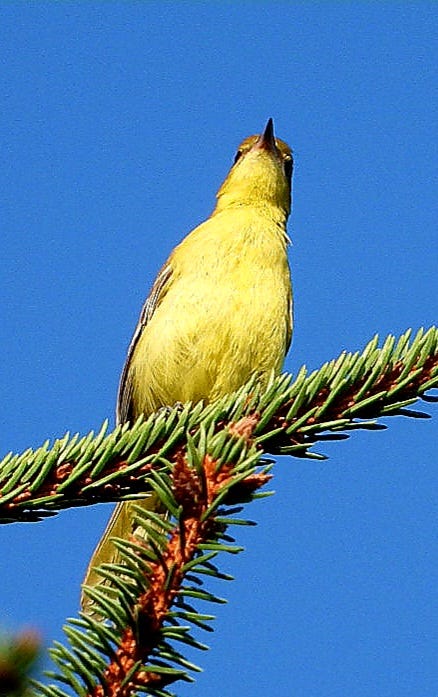
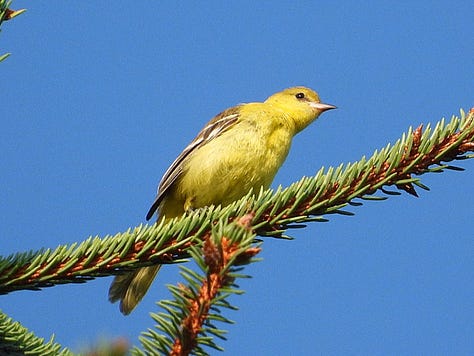
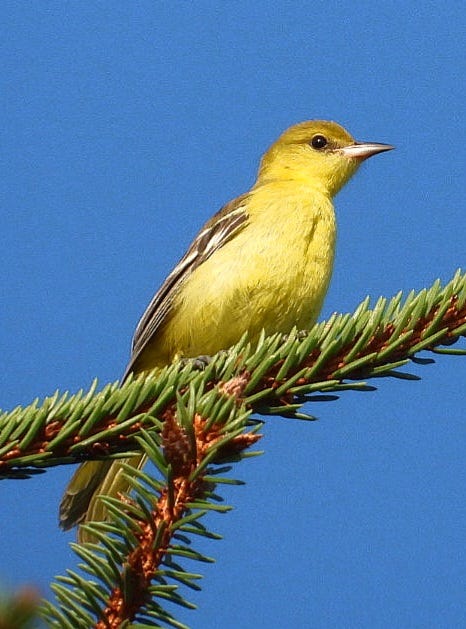
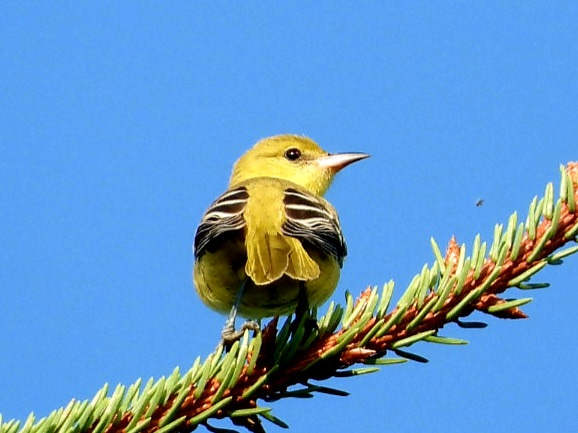

Down, Down, Down
Chalk it up to a different sit spot, but after going all the way to the Far Field and back, I can confidently say that we have finally passed the peak of Scarlet Tanagers and Red-eyed Vireos, at least, and probably several others. At the same time, the early warblers are gone or nearly so (no Ceruleans in days, for example), while the main warbler waves are yet to arrive. The upshot is that there is a paucity of warblers this weekend; perhaps a lot of them took advantage of the cold nights to head south. Meanwhile, the hot south winds will likely bottle up the northerners this week.
The meaning of all this?
Next weekend, or whenever we get north winds again, is going to be a combo of Buteo madness and warbler insanity. All we have to do is suffer through a heatwave with mid-nineties every day, and high humidity.
This will give me some time to go through the thousand-or-so NFCs that built up during that precious cold spell.

